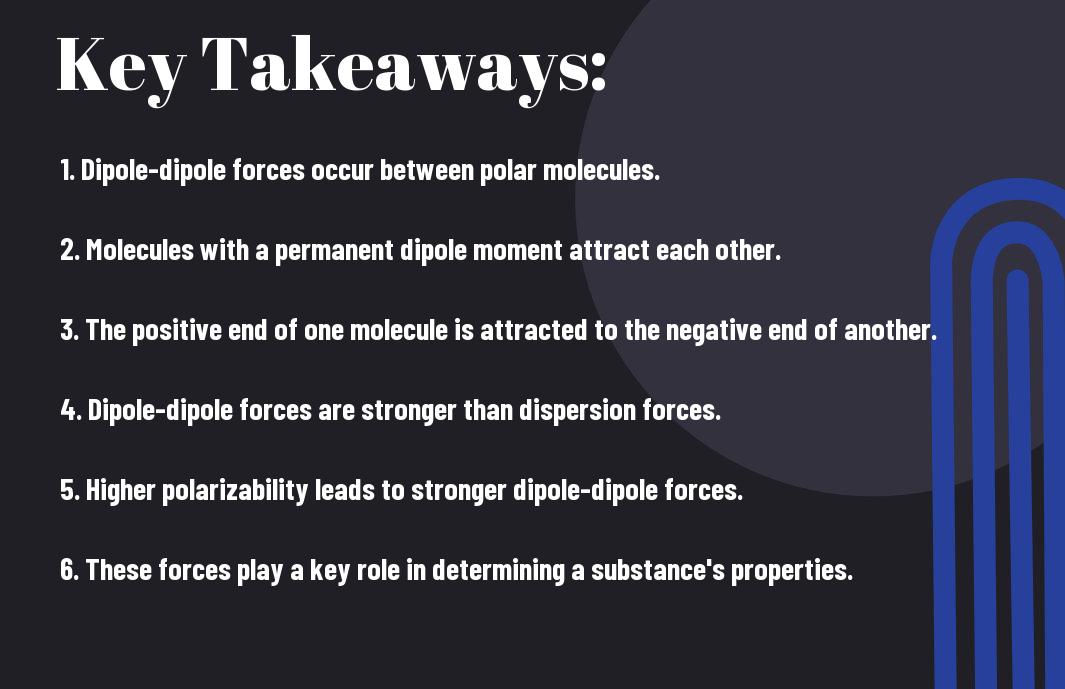Salutations, esteemed readers. Today, I will delve into the intriguing world of dipole-dipole forces and the basic principles of molecular attraction. These intriguing forces play a pivotal role in the properties and behaviors of various substances, influencing everything from the boiling point of a compound to its solubility in a solvent. Understanding these forces is essential for anyone studying chemistry or simply seeking a deeper understanding of the world around them. So, sit back, relax, and allow me to guide you through this fascinating topic.
Key Takeaways:
- Dipole-dipole forces are a type of intermolecular force that occurs between molecules with permanent dipoles, resulting in the attraction between the positive end of one molecule and the negative end of another.
- The strength of dipole-dipole forces is influenced by the magnitude of the individual dipoles, with larger dipoles resulting in stronger forces.
- Dipole-dipole forces are responsible for the high boiling and melting points of polar compounds, as the attraction between molecules requires more energy to overcome and separate them.
- These forces play a crucial role in determining the physical properties of substances, such as their solubility in polar solvents and their ability to form hydrogen bonds.
- Understanding dipole-dipole forces is essential in fields such as chemistry, biology, and material science, as it provides insight into the behavior of molecules and their interactions with each other.

Understanding Dipole-Dipole Forces
Before delving into the intricacies of dipole-dipole forces, it’s crucial to have a solid understanding of the principles underlying molecular attraction. These forces play a significant role in numerous chemical reactions and interactions, and understanding their mechanics is key to comprehending the behavior of various substances.
Definition of Dipole-Dipole Forces
Dipole-dipole forces are a type of intermolecular force that occurs between molecules with permanent dipoles. This means that the molecules have a positive and negative end due to differences in electronegativity, causing an uneven distribution of charge. As a result, the positively charged end of one molecule is attracted to the negatively charged end of another, leading to a dipole-dipole interaction.
Molecular Polarity and Dipole Moments
Molecular polarity is the result of differences in electronegativity between the atoms in a molecule, leading to an uneven distribution of charge. When a molecule is polar, it has a dipole moment, which is essentially a measure of the polarity of the molecule. The larger the difference in electronegativity, the more polar the molecule and the stronger the dipole-dipole forces it will exhibit.
Factors Affecting Dipole-Dipole Forces
Clearly, several factors can affect dipole-dipole forces between molecules. These factors include:
- Molecular Polarity: The greater the polarity of a molecule, the stronger the dipole-dipole forces between molecules. This is because the attraction between the partially positive end of one molecule and the partially negative end of another molecule is stronger when the polarity is higher.
- Molar Mass: Larger molecules have stronger dipole-dipole forces due to increased surface area for interaction between dipoles.
- Temperature: As temperature increases, the kinetic energy of molecules also increases, causing them to move faster and reducing the strength of dipole-dipole forces.
- Molecular Structure: The arrangement of atoms within a molecule can affect the strength of dipole-dipole forces. Molecules with symmetrical structures tend to have weaker dipole-dipole forces compared to molecules with asymmetrical structures.
After considering these factors, it becomes clear that the strength of dipole-dipole forces can be influenced by various molecular characteristics.
For more in-depth discussion on intermolecular forces, check out this Intermolecular Forces – CHEMISTRY COMMUNITY – Laurence Lavelle.
Molar Mass and Dipole-Dipole Forces
The molar mass of a molecule directly impacts its dipole-dipole forces. As the molar mass increases, the surface area available for interaction between dipoles also increases. This results in stronger dipole-dipole forces between molecules, contributing to a higher boiling and melting point of the substance.
Temperature and Dipole-Dipole Forces
The temperature has a significant impact on dipole-dipole forces. As the temperature rises, the kinetic energy of molecules also increases, causing them to move faster. This increased motion weakens the strength of dipole-dipole forces between molecules, ultimately leading to a decrease in the substance’s boiling and melting point.
| Factor | Effects on Dipole-Dipole Forces |
| Molecular Polarity | Increased polarity leads to stronger dipole-dipole forces. |
| Molar Mass | Higher molar mass results in stronger dipole-dipole forces. |
| Temperature | Higher temperature weakens dipole-dipole forces. |
| Molecular Structure | Symmetrical structures tend to have weaker dipole-dipole forces. |
Applications and Examples of Dipole-Dipole Forces
To understand the applications and examples of dipole-dipole forces, it is important to recognize the role these intermolecular forces play in various aspects of our daily lives. Dipole-dipole forces are responsible for the attraction between polar molecules, where the positive end of one molecule is attracted to the negative end of another. This type of molecular attraction can be observed in several real-world scenarios. For a more detailed understanding of dipole-dipole forces, you can refer to Dipole-Dipole Interactions.
Biological Significance of Dipole-Dipole Forces
The biological significance of dipole-dipole forces is profound, as these interactions are essential for various biological processes. In the context of biomolecules such as proteins and DNA, dipole-dipole forces contribute to the structural stability and functioning of these molecules. The alignment of polar biomolecules is facilitated by dipole-dipole forces, allowing for the formation of crucial hydrogen bonds. These interactions play a vital role in maintaining the three-dimensional structure of biomolecules, ultimately influencing their biological functions. Without dipole-dipole forces, the stability and functionality of biomolecules could be compromised, leading to detrimental effects on living organisms.
Industrial Applications of Dipole-Dipole Forces
Industrial processes also make extensive use of dipole-dipole forces, particularly in the realm of materials science and chemistry. One notable example is the use of polar solvents in various chemical reactions and processes. The ability of polar solvents to dissolve ionic and polar compounds is attributed to dipole-dipole interactions, which facilitate the separation and dispersion of solute particles. Additionally, the adhesion and cohesion of materials in industries such as adhesives, coatings, and paints are influenced by dipole-dipole forces. These forces contribute to the durability and effectiveness of industrial products, such as adhesives that form strong bonds and coatings that exhibit excellent protective properties.

Conclusion
Considering all points discussed, it is clear that dipole-dipole forces are a crucial aspect of molecular attraction. Understanding the principles of this type of intermolecular force is essential for grasping the behavior of substances in various contexts, such as solubility and boiling points. By being able to identify and comprehend the role of dipole-dipole forces, you can gain a deeper understanding of the interactions between molecules and their resulting physical properties. Overall, having a firm grasp of dipole-dipole forces is fundamental to the study and application of chemistry.
FAQ
Q: What is a dipole-dipole force?
A: A dipole-dipole force is a type of intermolecular force that occurs between polar molecules. These forces result from the attraction between the positive end of one polar molecule and the negative end of another polar molecule.
Q: How do dipole-dipole forces differ from other types of intermolecular forces?
A: Dipole-dipole forces specifically involve the attraction between the positive and negative ends of polar molecules, whereas other types of intermolecular forces, such as London dispersion forces and hydrogen bonding, involve different mechanisms of molecular attraction.
Q: What principles govern dipole-dipole forces?
A: Dipole-dipole forces are governed by the principle of electrostatic attraction. The strength of the dipole-dipole force depends on the magnitude of the molecular dipoles and the distance between the dipoles.
Q: How do dipole-dipole forces affect physical properties of substances?
A: Dipole-dipole forces play a significant role in determining the boiling and melting points of substances. Molecules with stronger dipole-dipole forces generally have higher boiling and melting points due to the increased energy required to overcome these intermolecular attractions.
Q: In what ways are dipole-dipole forces relevant in the study of chemistry and physics?
A: Understanding dipole-dipole forces is essential for predicting and explaining the behavior of substances in various chemical and physical processes, including phase changes, solubility, and the behavior of materials in different conditions.









Leave a comment